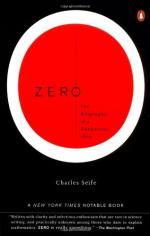
|
| Name: _________________________ | Period: ___________________ |
This test consists of 15 multiple choice questions and 5 short answer questions.
Multiple Choice Questions
1. How was Giordano Bruno executed?
(a) He was given lethal injection.
(b) He was burned at the stake.
(c) He was hung.
(d) He was shot by firing squad.
2. Approximately when was Giordano Bruno born?
(a) 1366.
(b) 1623.
(c) 1548.
(d) 1459.
3. Copernicus developed what kind of model of the universe?
(a) A heliocentric model.
(b) A culture centric model.
(c) A geocentric model.
(d) A lunar centric model.
4. Pythagoreanism developed into two separate schools of thought. What group was called “the listeners” in Greek?
(a) The Hippasusikoi.
(b) The omnimatioi.
(c) The mathēmatikoi.
(d) The akousmatikoi.
5. What term refers to an argument that produces an inconsistency?
(a) Quantization.
(b) Dividend.
(c) Reprimand.
(d) Paradox.
6. What does the author refer to as “zero’s twin” in the book?
(a) Infinity.
(b) Thirteen.
(c) Seven.
(d) One.
7. The author notes in Chapter 2, “Nothing Comes of Nothing” that the West resisted the concept of zero for how many years?
(a) 1,000.
(b) 500.
(c) 2,000.
(d) 3,000.
8. What name refers to sutra texts belonging to the Śrauta ritual and containing geometry related to fire-altar construction?
(a) The Kartikeya.
(b) Shavi Sutras.
(c) Shulba Sutras.
(d) Yogi Sutras.
9. What refers to a system in which the location of a point is given by coordinates that represent its distances from perpendicular lines that intersect at a point called the origin?
(a) The Pythagorean system.
(b) The Babylonian system.
(c) Cartesian coordinate system.
(d) The Golden Ratio.
10. Aristotle referred to Zeno of Elea as the inventor of what?
(a) Geometry.
(b) The Zeno theorem.
(c) Algebra.
(d) The dialectic.
11. The system that equipped the USS Yorktown in 1996 and 1997 was predicted to save $2.8 million per year by reducing the ship’s complement by what percentage?
(a) 20%.
(b) 10%.
(c) 5%.
(d) 30%.
12. The author states in Chapter 2, “Nothing Comes of Nothing” that the concepts of infinity and the void frightened the ancient Greeks. They feared the infinite because it threatened the possibility of what?
(a) The Devil.
(b) Motion.
(c) God.
(d) Time.
13. The ancient Babylonians are credited with the creation of what calculation tool?
(a) The calculator.
(b) The abacus.
(c) The computer.
(d) The stick-stone.
14. The ancient Babylonians had a number system based on what increment?
(a) 60.
(b) 20.
(c) 10.
(d) 5.
15. The ancient Egyptians used math to create what type of calendar?
(a) A geocentric calendar.
(b) A solar calendar.
(c) A lunar calendar.
(d) A plexus calendar.
Short Answer Questions
1. What refers to the mean obtained by taking the reciprocal of the arithmetic mean of the reciprocals of a set of nonzero numbers?
2. How many minutes made up an hour in the ancient Greek system?
3. Pythagoreanism was a cult that greatly influenced what philosophical system?
4. Zeno of Elea followed what Eleatic school founder in believing that the nature of the universe was changeless and immobile?
5. The preclassic Maya and their neighbors supposedly developed the concept of zero by what year?
|
This section contains 435 words (approx. 2 pages at 300 words per page) |

|




